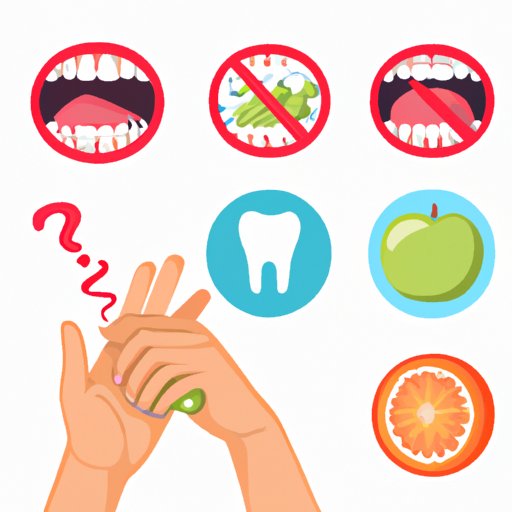
Introduction
Scurvy may sound like a disease of the past, but it is still a relevant concern today. This condition develops when the body does not get enough Vitamin C, leading to a range of symptoms that can impact overall health. Understanding the signs of scurvy is crucial in preventing deficiency and maintaining optimal health.
5 Signs That You May Have Scurvy: Understanding the Symptoms
Scurvy symptoms can manifest in a variety of ways, making it challenging to diagnose. Here are five common symptoms to look out for:
Fatigue and weakness
Scurvy can lead to overall feelings of fatigue and weakness. Vitamin C is essential for collagen production, which helps maintain muscle strength.
Joint pain
Joins can become painful and tender in people with scurvy. Vitamin C plays an essential role in maintaining the health of cartilage and can impact joint mobility.
Swollen or bleeding gums
Bleeding gums are a classic sign of scurvy, and this symptom typically occurs before other visible signs. Vitamin C is crucial for gum health as it helps support the health of blood vessels.
Bruising easily
Another sign of scurvy is easy bruising due to weak blood vessels. Along with Vitamin C, other nutrients like Zinc and Vitamin K play a role in maintaining healthy blood vessel function.
Dry, scaly skin
People with scurvy may experience dry, rough, and scaly skin due to a lack of collagen production. Vitamin C helps regulate collagen synthesis that contributes to healthy skin.
Uncovering the Signs of Scurvy: How to Recognize the Symptoms
Scurvy symptoms are often a result of a deficiency of essential vitamins and minerals like Vitamin C, Zinc, and Vitamin K. Maintaining an adequate intake is crucial in preventing deficiency. Here are some vital vitamins and minerals the body needs to prevent scurvy:
Vitamin C: This nutrient is vital for collagen synthesis, wound healing, immune function, and healthy blood vessels. Some good sources include citrus fruits, papaya, kiwifruit, tomato, capsicum, brussels sprouts, and berries.
Zinc: This mineral plays a role in many physiological processes including wound healing, immunity, and DNA synthesis. Good sources include red meat, poultry, seafood, and legumes.
Vitamin K: This nutrient is crucial for healthy blood clotting and bone health. Good sources include green vegetables, leafy greens, vegetable oils, and nuts.
Additionally, lifestyle factors can impact the risk of scurvy. Smokers and heavy drinkers are at increased risk due to poor nutrient absorption. Individuals with limited dietary diversity and restrictive diets are also at risk of deficiency.
The Warning Signs of Scurvy: What You Need to Know
Scurvy can cause internal symptoms, which can be more severe. Here are some warning signs to be aware of:
Muscle aches and stiffness
Vitamin C plays a role in maintaining muscle health and can lead to pain and stiffness when deficient.
Shortness of breath
In advanced stages of scurvy, shortness of breath and chest pain can occur due to heart issues.
Anemia
The lack of Vitamin C can affect the absorption of Iron, leading to anemia. This can cause weakness, dizziness, and shortness of breath.
Fever and chills
In serious cases, fever and chills can be a sign of an infection caused by poor immune function due to Vitamin C deficiency.
Could You Have Scurvy? Check for These Symptoms
If you’re concerned about scurvy, here are some signs to look for:
– Fatigue and weakness
– Joint pain
– Swollen or bleeding gums
– Bruising easily
– Dry, scaly skin
– Muscle aches and stiffness
– Shortness of breath
– Anemia
– Fever and chills
It’s essential to note that these symptoms can be present in other conditions. However, if you experience any of these symptoms, it’s necessary to get a proper diagnosis and seek appropriate treatment.
A Comprehensive Guide to the Symptoms of Scurvy
Scurvy can progress from mild to severe when left untreated. Let’s take a closer look at the symptoms of scurvy:
– Mild Scurvy: In the early stages, minor symptoms such as fatigue and weakness may be present.
– Moderate Scurvy: As scurvy progresses, joint pain and swollen or bleeding gums can occur. Skin may become dry and scaly, and easy bruising may occur as well.
– Severe Scurvy: In advanced cases, muscle aches and stiffness, shortness of breath, anemia, fever, and chills can occur.
It’s important to note that scurvy is rare in developed countries due to the availability of a broad range of foods. Those at risk, such as smokers, heavy drinkers, and individuals with restrictive diets, should pay close attention to their nutrient intake.
Don’t Ignore These Symptoms: How to Identify and Treat Scurvy
Early detection and treatment of scurvy are crucial. Here’s what you need to know:
– Self-diagnosis is not recommended: If you suspect you have scurvy, it’s essential to get a proper diagnosis from a healthcare professional.
– Treating scurvy: Treatment of scurvy involves Vitamin C supplementation. Ensure that you’re taking the recommended daily allowances of essential vitamins and minerals to prevent scurvy.
– Foods rich in Vitamin C: Some foods rich in Vitamin C are oranges, lemons, grapefruit, strawberries, kiwi, mango, papaya, and pineapple.
– Incorporating Vitamin C into your daily routine: You can also get Vitamin C from over-the-counter supplements and multivitamins. Always purchase Vitamin C supplements from reputable sources and consult with your doctor if you’re not sure about how much to take.
Conclusion
Scurvy is caused by a deficiency of essential vitamins and minerals like Vitamin C, Zinc, and Vitamin K. Understanding the symptoms is crucial in diagnosing scurvy early and preventing serious complications. A balanced diet that includes a variety of foods rich in essential nutrients and a healthy lifestyle can help prevent scurvy and optimize overall health. If you notice any of the symptoms of scurvy, seek medical attention and get an appropriate diagnosis and treatment plan.




